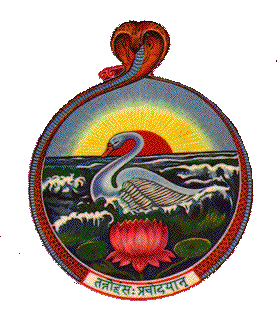The emblem of the Ramakrishna Order |
|||
The origination of the emblem of the Ramakrishna order Laura Glenn (Sister Devamata) wrote: The design which has become the symbol of the Ramakrishna Mission everywhere came into being in the same casual way as did the "Song of the Sannyasin." It took shape in 1900 during Swami Vivekananda's later visit to America . At that time the Vedanta Society of New York was definitely established and occupied a modest house in Fifty-eighth Street . Mrs. Crane, the housekeeper, told me that the Swami was sitting at the breakfast table one morning when the printer arrived. He said he was making a circular for the Society and wished to have an emblem to go on it, could the Swami suggest something? Swamiji took the envelope from a letter he had just received, tore it open and on the clean inner surface drew the waves, the swan, the lotus, and the sun circled by a serpent -- the four Yogas wrapped about by eternity, it seemed. He threw the bit of paper with the design on it across the table and said, "Draw it to scale." Henry van Haagen, the printer, was an able draftsman as well as printer. He converted the rough sketch into a finished drawing. After his return to India, Swamiji explained the significance of the design to the artist Ranadaprasad Das Gupta: "The wavy waters in the picture are symbolic of Karma, the lotus, of Bhakti; and the rising-sun, of Jnana; The encircling serpent is indicative of Yoga and the awakened Kundalini Shakti, while the swan in the picture stands for the Paramatma (Supreme Self). Therefore, the idea of the picture is that by the union of Karma, Jnana, Bhakti, and Yoga, the vision of the Paramatman is obtained.
|
- www.vivekananda.net edited by Frank Parlato Jr.
